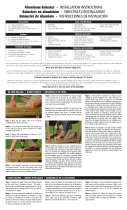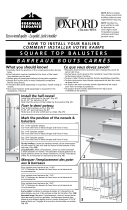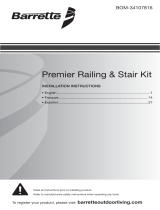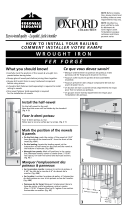
6492
EASY POOL STEP — (NE113)
Above are the options available with use of the Easy Step. The cartons and instructions
necessary will vary depending on which set-up you have purchased. Please find the mode
you purchased on the next page and note the information regarding location of the instructions
and assembly.
EASY POOL STEP
ENTRY SYSTEM
(NE138)
(With Gate)
(4 CARTONS)
EASY POOL STEP
WITH OUTSIDE LADDER
(NE126)
FOR USE WITH:
EASY POOL STEP
(NE113)
(1 CARTON)

2
• Small rubber mallet or hammer w/piece of wood
• Phillips head screwdriver
• Pliers
• Liquid soap or lubricant
• 40 lbs. of sand (sold separately)
• Funnel
TOOLS REQUIRED
EASY POOL STEP
(NE113)
This carton (NE113) contains ALL the necessary pieces and instructions for installation of
your new step. Please follow all instructions for proper installation of this step.
EASY POOL STEP WITH OUTSIDE LADDER
(NE126)
EASY POOL STEP ENTRY SYSTEM
(NE138)
NOTE
The sequence of the instructions may vary at points
depending on the type of step system that you have
purchased. If there are different instructions for your
system, it WILL BE indicated within the step.
Please follow these notes to avoid additional steps and
wasted time.
This is carton 1 of 2. The step and the necessary instructions for installation are included
within this carton. You should have a second carton labeled which contains the outside
ladder for this system (NE126B). All the necessary instructions for installation of the ladder
are located inside the second carton.
There are four cartons necessary to install your new bridge. You should have 2 step cartons
(NE113) which include the instructions necessary to install the steps only. The third
carton contains the crossover (NE138B) necessary to connect the two steps. The instructions
for the assembly and installation of the crossover are located in the crossover box. Carton 4
is the gate carton (NE138C) which includes the necessary components for the gate and
instructions for gate installation.

PARTS & HARDWARE FOR STEP
A. LONG HANDRAIL POST (2)
(NEP2120)
B. SHORT HANDRAIL POST (2)
(NEP2017)
C. STEPS (4)
(NEP2018)
D. RISERS (4)
(NEP2016)
E. BASES (2)
(NEP2010)
F. MOUNTING BRACKETS (2)
(NEP2015)
3
G. HANDRAILS (2)
(NEP2012)
H. SIDE PANELS (2)
(AC PANELS)
I. LOCK CAPS (16)
(NEP2014)
J. HARDWARE
(NEP2013)
• 14 - 1-1/4” screws
K. DANGER STICKERS
(NEP2011)

STEP 1
• Lay one of the side panels (H) down on a flat surface.
• Each step (C) has a groove where the riser will slide in
which is located on the bottom of each step.
• Line up a step (C) by positioning the connected dowels
on the step with two of the round holes on the side
panel (H). NOTE: Make sure that the treads on the step
are facing towards the T
OP of the side panel (the skin-
nier part of panel) and that the riser groove on the step
is towards the back of the step.
• Push the step until it clicks in place. Repeat for each of
the three remaining steps (C). If necessary, you may use
the rubber mallet or hammer with wood on top to tap
into place.
STEP 2
4
• Insert a riser (D) between each of the steps. Locate
the hole in the center of the riser. This hole should
face towards the back of the side panel.
• The riser should slide right into the grooves on the
steps and the square notches should fit right into
the recessed openings on the panel.
• Repeat for each of the three remaining risers.
STEP 3
• Once all risers are in place, line up second side
panel with the connected dowels on installed steps.
• Push down on side panel to lock in place, if neces-
sary use rubber mallet or (hammer with piece of
wood) to fully seat side panel.
TOP OF PANEL

STEP 4
• Leave the side panel facing upward and position one
of the lock caps (I) centered over any hole on the
side panel.
• Using a small rubber mallet or a (block of wood and
a small hammer), tap on the locking cap until it is
secured over the pin sticking through the side of the
step and is flush with the side panel.
• Repeat this procedure for each of the additional
seven openings on this side of the step.
• Flip step so that other side panel is facing upwards
and repeat above for the eight holes on this side.
5
STEP 5
• Leave the side panel facing upward and posi-
tion one of the bases (E) under the side panel
with the channel against the step.
• Secure the base to the side panel with
two zip ties. There is a molded groove in
the base for placement of the zip tie.
Tighten zip tie securely.
• Repeat for opposite side.
NOTE
Zip tie should catch and lock when pulled tight, if it does not then
turn the zip tie over and reattach.
NOTE
To prevent damage to liner, make sure that the locking tab on zip
tie is positioned so that it will NOT come in contact with liner.

6
STEP 6
STEP 7
• Stand step upright and locate two short handrail posts (B).
• The short handrail posts should be installed into the holes
located on the second step with closed end inside the hole
and the open end facing up.
• Screw handrail posts into place using (2) screws from
hardware bag (J).
• Once step is placed in pool, tip the step
forward and move it left and right to
ensure that air escapes and water enters
the steps and risers. This will help keep
the step stationary in the pool.
• In order for step to sit properly
, it must be
weighted in place using approximately
40 lbs of sand. To weight step, place
funnel in opening of side panel on top
step that is now inside pool. Pour 20 lbs
of sand into EACH side of the step.
NOTE
When installing a step inside of your pool it is recommended to
install a step mat underneath to protect your liner. This item is sold
separately.
NOTE
You may need to rock the step back and forth a little to distribute
the sand so the 20 lbs will fit in each side of the step.
Place funnel up
here and pour
sand through
these posts
NOTE
Do NOT install long handrail posts at this time,
they must be installed after completing Step 7.
• Place assembled step INSIDE the pool where you would like to enter the pool. Filter
should be switched off to stop water circulation.
a. If you have a deck, position step in area where it can be attached to your deck.
b. If you have the Easy Step without ladder or Easy Pool Step Entry System
position step where you would like to enter the pool.

7
STEP 8
• The two long handrail posts (A) should be installed into the holes located at the
back of the step.
• When installing these posts, make sure that the closed end goes into the opening
and that the open end is facing up.
• Once in place, secure using (2) screws from hardware bag (J).
STEP 9
• If you are reading this step, then you will be attaching
this staircase to an existing deck at the pool site. If you
are NOT installing this step to a deck, please refer to
the above notes for your next step.
• Locate mounting brackets (F) and slide one over each
of the long handrail posts. These will be used to secure
your step to your decking.
• Adjust mounting brackets height-wise so that they are
even with your deck. Once these are even, make sure
step is where you would like it in pool. Make sure the
upright posts are as close as possible to pool top rails.
NOTE
If you are having a problem getting the handrail posts in due to the
sand, rock the step left and right to distribute sand.
**IF YOU ARE INSTALLING THE EASY POOL STEP WITH OUTSIDE LADDER,
PLEASE REFER TO NE126B OUTSIDE LADDER INSTRUCTIONS AT THIS TIME.
**IF YOU ARE INSTALLING THE EASY POOL STEP ENTRY SYSTEM, PLEASE
REFER TO NB138B CROSSOVER INSTRUCTIONS AT THIS TIME.
NOTE
Step MUST be secured to deck to prevent rocking or tipping. If the mounting
brackets do not reach the deck, you will need to extend that part of the deck
surface so that the brackets can be screwed in place.
• Attach mounting brackets by screwing into deck through two of the three holes on each mounting
bracket (choose the openings that best fits your deck). The screws necessary for attachment are
NOT included as there are several types of deck materials and the necessary screws will vary.

8
STEP 10
SAFETY INFORMATION
• Lubricate inside of long and short handrail posts with liq-
uid soap or lubricant.
• Attach handrails (D) to handrail posts by pushing into
posts. The more curved part of the handrail is meant to
be installed in the long handrail post.
• Using (4) screws from hardware bag (J), secure
handrails in place.
• Stick one danger sticker (K) on each handrail so that
one faces inside the pool and the other faces the
outside.
• When lifting heavy or awkward loads, it is suggested that two people lift
to avoid injury
.
• DO NOT use the pool steps for any purpose other than that for which
which it is intended.
• Maximum weight on steps should NOT exceed 350 lbs.
MAINTENANCE
WARNING
Exceeding the recommended weight limit may cause the step
to fail and may result in injury.
• Step/ladder/bridges must be removed for winter, failure to do so can cause
the step to crack.
• When removing step/ladder/bridges for winter, it is recommended that you
spray down step with hose water to rinse off any chemical residual prior to
storing.
• When storing step/ladder/bridges for winter
, it should be protected from
the elements and stored either in a shed or garage, or covered with a tarp.

6492
Marches EASY STEP pour piscine — (NE113)
Marches EASY STEP pour
piscine et système d’entrée
(NE138)
(avec barrière)
(4 boîtes)
Marches EASY STEP pour
piscine avec échelle
extérieure
(NE126)
Utiliser avec
Marches EASY STEP pour piscine
(NE113)
(1 boîte)
Les différentes façons d’utiliser les marches EASY STEP pour piscine sont illustrées ci-dessus. Le
nombre de boîtes ainsi que les instructions nécessaires peuvent varier selon le modèle que vous
avez acheté. Veuillez consulter la page suivante pour vous renseigner sur le modèle que vous avez
choisi; veuillez bien prendre note de l’emplacement des instructions et d’assemblage.

Cette boîte (NE113) contient TOUTES les instructions et les pièces nécessaires à l’installation de
votre nouvel escalier pour piscine. Suivez attentivement les instructions pour l’installer
adéquatement.
Cette boîte est la première de 2. L’escalier et les instructions nécessaires à l’installation sont inclus
dans cette boîte. Il y a également une deuxième boîte étiquetée qui contient l’échelle extérieure
pour ce modèle. (NE126B). Les instructions nécessaires à l’installation de l’échelle sont contenues
dans la deuxième boîte.
Vous devez avoir quatre boîtes pour installer votre nouvelle plate-forme. Vous devriez avoir deux
boîtes pour les marches (NE113), avec à l’intérieur, les instructions nécessaires pour installer les
marches seulement. La troisième boîte contient la plate-forme (NE138B) pour joindre l’escalier et
l’échelle. Les instructions d’assemblage et d’installation de la plate-forme sont contenues à
l’intérieur de la boîte. La quatrième boîte (NE138C) contient la barrière ainsi que les accessoires et
les instructions pour installer la barrière.
2
OUTILS REQUIS
Marches EASY STEP pour piscine avec
échelle extérieure (NE126)
Marches EASY STEP pour piscine avec
système d’entrée (NE138)
AVIS
Marches EASY STEP pour piscine (NE113)
La séquence des instructions peut varier selon le modèle
de marches que vous avez acheté. S'il y a différentes
instructions pour votre modèle, elles seront INDIQUÉES
lors de l’étape à suivre. Veuillez suivre attentivement ces
notes afin d'éviter les étapes inutiles et la perte de temps
• Petit maillet en caoutchouc ou marteau et morceau de bois
• Tournevis cruciforme
• Pinces
• Savon liquide ou lubrifiant
• 18 kilos de sable (vendus séparément)
• Entonnoir

PIÈCES & QUINCAILLERIE POUR EASY STEP
A. POTEAUX LONGS (2)
(NEP 2120)
B. POTEAUX COURTS (2)
(NEP 2017)
C. MARCHE (4)
(NEP 2018)
D. CONTREMARCHE (4)
(NEP 2016)
E. BASE (2)
(NEP 2010)
F. SUPPORT DE MONTAGE (2)
(NEP 2015)
3
G. RAMPE (2)
(NEP 2012)
H. PANNEAU LATÉRAL (2)
(AC PANELS)
I. BOUCHON
D’ANCRAGE (16)
(NEP 2014)
J. QUINCAILLERIE
(NEP 2013)
• 14 - 1-1/4” vis
K. AUTOCOLLANT DANGER
(NEP 2011)

ÉTAPE 1
ÉTAPE 2
4
ÉTAPE 3
HAUT DU PANNEAU
• Déposer un des panneaux latéraux (H) sur une
surface plane.
• Chaque marche (C) a une rainure située au bas où
faire glisser la contremarche.
• Alignez une marche (C) en positionnant les chevilles
de la marche avec les deux trous ronds du panneau
latéral (H). REMARQUE : s’assurer que les bandes
sur la marche sont tournées vers le HAUT du
panneau latéral (la partie mince du panneau) et que
la rainure de la contremarche est tournée vers
l'arrière de la marche.
• Poussez sur la marche jusqu'à ce qu'elle
s'enclenche. Répéter pour chacune des trois étapes
restantes (C). Si nécessaire, vous pouvez utiliser un
maillet de caoutchouc ou un marteau avec un
morceau de bois pour taper et la fixer en place.
• Insérer la contremarche (D) entre chacune des marches.
Repérer le trou au centre de la contremarche. Ce trou doit
faire face vers l'arrière du panneau latéral.
• La contremarche devrait glisser dans la rainure de la
marche et les encoches carrées devraient s’insérer dans
les ouvertures encastrées du panneau.
• Répéter pour chacune des trois contremarches.
• Une fois que toutes les contremarches sont en place,
aligner le deuxième panneau latéral avec les chevilles
fixées sur les marches installées.
• Appuyez sur le panneau latéral pour le fixer en place, si
nécessaire, utilisez un maillet en caoutchouc ou un
marteau avec pièce de bois pour fixer le panneau
adéquatement.

• Le panneau latéral est tourné vers le haut et placer un des
bouchons de plastique (I), le centrer sur n'importe un des
trous du panneau latéral.
• À l'aide d'un maillet en caoutchouc ou d’un petit marteau
avec un morceau de bois, tapez sur le bouchon d’ancrage
jusqu'à ce qu'il s’accroche à la cheville du côté de la
marche et affleure le panneau latéral.
• Répéter cette procédure pour chacun des sept autres
trous supplémentaires situés sur ce côté de l’escalier.
• Retourner la marche afin que l'autre panneau latéral soit
vers le haut et répétez les étapes ci-dessus pour les huit
trous de ce côté.
• Laisser le panneau latéral vers le haut et placer
une des bases (E) sous le panneau latéral
avec le canal appuyé sur la marche.
• Avec deux attaches, fixer la base du panneau
latéral. Il y a une rainure moulée dans la base
pour installer l'attache. Serrez l'attache
solidement.
• Répéter pour l'autre côté.
ÉTAPE 4
5
ÉTAPE 5
AVIS
Quand l’attache est tirée elle doit attacher et fermer, si elle ne ferme
pas, tourner l'attache de l’autre côté et rattacher de nouveau.
AVIS
Pour ne pas endommager le liner, s’assurer que la languette de
fermeture de l'attache n’est pas en contact avec le liner.

• Mettre l’escalier debout et installer les deux poteaux courts de la rampe (B).
• Les poteaux courts doivent être installés dans les trous situés sur la
deuxième marche, l’extrémité fermée à l'intérieur du trou et l'extrémité
ouverte vers le haut.
• Visser la main courante à l'aide des vis (2) du sac de quincaillerie (J).
6
ÉTAPE 6
ÉTAPE 7
AVIS
AVIS
Placer l'entonnoir
ici et verser le
sable dans le
poteau.
NE PAS installer les poteaux longs de la
rampe, ces derniers doivent être installés
après l'étape 7.
AVIS
a. Si vous avez un patio, installer les marches dans la zone où elles peuvent y être attachées.
b. Si vous possédez le EASY STEP sans échelle ou le système d’entrée EASY STEP,
installer à l’endroit où vous souhaitez entrer dans la piscine.
• Placer l’escalier assemblé à l'INTÉRIEUR de la piscine à l’endroit où vous souhaitez entrer
dans la piscine. Le filtre doit être mis hors tension pour arrêter l’eau de circuler.
Lors de l'installation de marches à l'intérieur de votre piscine, il
est recommandé d'installer un sous-tapis pour protéger votre
liner. Cet article est vendu séparément.
Il faut peut-être basculer les marches (mouvement avant et arrière) pour répartir
le sable uniformément et qu’il y ait 20 kg de sable de chaque côté des marches.
• Une fois les marches à l’intérieur de la
piscine, faire bouger l’escalier de droite
à gauche pour que l’air puisse
s’échapper et que l’eau puisse pénétrer
à l’intérieur des marches et des
contremarches. Cela aidera à garder les
marches stationnaires dans la piscine.
• Afin que les marches soient mises en
place correctement, on doit les stabiliser
à l’aide de 40 kg de sable. Pour ce faire,
installer l’entonnoir dans l'ouverture du
poteau fixé sur la plus haute marche à
l'intérieur de la piscine. Mettre 20 kg de
sable de chaque côté des marches.

7
ÉTAPE 8
ÉTAPE 9
AVIS
AVIS
.
• Les poteaux longs pour la rampe (A) doivent être installés dans les trous situés à
l'arrière des marches.
• Lors de l'installation des poteaux longs, s’assurer que l'extrémité fermée soit dans
le trou et que l'extrémité ouverte soit vers le haut.
• Une fois en place, fixer à l'aide des 2 vis du sac de quincaillerie (J).
Si vous rencontrez un problème en fixant les poteaux de la
rampe en raison du sable, secouer les marches de gauche à
droite pour le distribuer uniformément.
** SI VOUS INSTALLEZ l’ÉCHELLE EXTÉRIEURE DU EASY POOL STEP,
VEUILLEZ CONSULTER LES INSTRUCTIONS NEP126B EN RAPPORT AVEC
L’ÉCHELLE EXTÉRIEURE.
** SI VOUS INSTALLEZ LE SYSTÈME D'ENTRÉE DE PISCINE EASY POOL STEP,
VEUILLEZ CONSULTER LES INSTRUCTIONS DE LA PLATEFORME NB138B.
• La présente étape indique comment fixer l’escalier au
patio situé près de la piscine. Si vous n'installez pas
d’escalier sur le patio, veuillez consulter les notes
ci-dessus pour connaître la prochaine étape.
• Trouver les supports de montage (F), en faire glisser
un sur chacun des poteaux longs de la rampe. Ils
aident à assurer vos pas sur le patio.
• Ajuster les supports de montage en hauteur pour qu’ils
soient au niveau du patio. Dès que les supports sont
au niveau, installer les marches à l’endroit souhaité
pour entrer dans la piscine. S'assurer également que
les poteaux soient aussi près que possible des
montants supérieurs de la piscine.
• Fixez les supports de montage en les vissant dans le patio à l’aide de deux ou trois trous sur
chaque support (choisir les ouvertures qui s'adaptent le mieux à votre plateforme). Les vis pour
fixer les pièces ne sont pas incluses, car il existe plusieurs types de matériaux pour patio et la
taille des vis peut varier.
Pour qu’il soit solide et ne bascule pas, l’escalier doit être fixé au patio.
Si les supports de montage ne peuvent pas être fixés sur le patio, il
faudra installer une rallonge pour visser les supports en place.

8
ÉTAPE 10
CONSIGNES DE SÉCURITÉ
ENTRETIEN
SI la limite de poids n’est pas respectée, cela
peut endommager l’équipement et causer des
blessures.
AVERTISSEMENT
• Lubrifier l'intérieur de la rampe et l’intérieur des poteaux
longs et courts avec du savon liquide ou un lubrifiant.
• Attacher les rampes (D) aux poteaux en appuyant sur les
poteaux. La partie courbée de la rampe s’installe dans le
poteau long.
• À l'aide des 4 vis à l’intérieur du sac de quincaillerie (J),
sécuriser les rampes.
• Apposer l’étiquette danger (K) sur chaque rampe, une doit
faire face à l'intérieur de la piscine et l'autre fait face à
l'extérieur.
• Pour éviter toute blessure, il est recommandé de demander de l’aide pour
soulever une charge lourde ou encombrante.
• Ne pas se servir des marches de la piscine pour un autre usage que celui
pour lequel elles sont destinées.
• Poids maximum sur les marches NE DOIT PAS dépasser 159 kg.
• L’échelle, la plateforme et les marches doivent être retirées pendant l'hiver, sinon,
les marches risquent de craquer.
• Avant de remiser l’échelle, la plateforme et les marches pour l'hiver, il est
recommandé de les laver avec un boyau d’arrosage pour enlever tout résidu de
produit chimique.
• Avant de remiser l’échelle, la plateforme et les marches, il faut les protéger des
intempéries, soit les ranger dans un hangar ou garage ou les recouvrir d'une bâche.
-
 1
1
-
 2
2
-
 3
3
-
 4
4
-
 5
5
-
 6
6
-
 7
7
-
 8
8
-
 9
9
-
 10
10
-
 11
11
-
 12
12
-
 13
13
-
 14
14
-
 15
15
-
 16
16
dans d''autres langues
- English: Blue Wave NE113 User manual
Autres documents
-
Fusion 6501125 Guide d'installation
-
 ProWood 66017 Mode d'emploi
ProWood 66017 Mode d'emploi
-
Pylex 13920 Guide d'installation
-
 Colonial Elegance SKBN455 Mode d'emploi
Colonial Elegance SKBN455 Mode d'emploi
-
Lifetime 90971 Le manuel du propriétaire
-
Lifetime 90966 Le manuel du propriétaire
-
Lifetime 90966 Le manuel du propriétaire
-
 Veranda 73045452 Guide d'installation
Veranda 73045452 Guide d'installation
-
Pentair Legend Platinum II Manuel utilisateur
-
 Colonial Elegance WB60036-P05 Mode d'emploi
Colonial Elegance WB60036-P05 Mode d'emploi



















